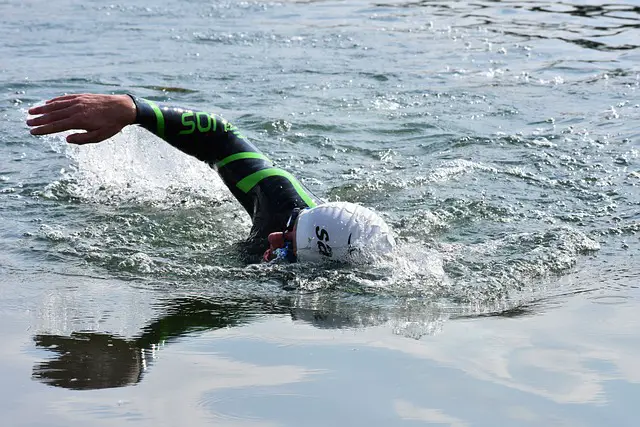What Do You Wear Under A Wet Suit

Wearing the right clothing underneath a wet suit is essential for keeping warm and comfortable while in the water. Not only does it provide an extra layer of insulation, it also helps to prevent chafing and skin irritation. In this article, we’ll discuss what you should wear under a wet suit and why it matters.When wearing a wet suit, it is important to wear the correct clothing underneath. It is recommended to wear a thin, lightweight bathing suit or a rash guard to provide an extra layer of warmth and comfort. Wearing clothing that is too loose may cause chafing and discomfort when wearing the wetsuit. Additionally, avoid wearing cotton as it will absorb water and make you colder. Wearing a swim cap and neoprene booties can also help to keep you warm and comfortable in cold waters.
Types of Underwear for a Wet Suit
When it comes to wet suits, you need proper underwear for the best performance and comfort. The right type of underwear will help keep you warm, dry, and comfortable while you are in the water. Depending on the type of wet suit and activity, there are several types of underwear suitable for different occasions. Here are some of the best types of underwear for a wet suit:
Neoprene Shorts
Neoprene shorts are the most common type of underwear for a wet suit. They are designed to fit snugly against your body so that no water can get in between them and your skin. This helps keep you warm by trapping body heat close to your skin. Neoprene shorts come in a variety of sizes and styles so you can find the perfect pair that fits your needs.
Thermal Tops
If you are going to be out in cold water, then thermal tops may be a good choice. These tops are designed to trap body heat as well as wick away moisture so that it doesn’t make you feel cold or clammy while underwater. Thermal tops can also provide extra warmth if needed.
Lycra/Spandex Shorts
Lycra/Spandex shorts provide more coverage than neoprene shorts but still allow for maximum flexibility in the water. They also wick away moisture so that your skin stays dry even when submerged in the water. Lycra/Spandex shorts come in a variety of colors and styles so you can find something that suits your style.
Rash Vests
Rash vests are designed to protect sensitive areas like your chest and back from getting chafed by a wet suit or from rough surfaces like coral reefs or rocks. They also help prevent sunburns when out on open-water activities like surfing or kayaking. Rash vests come in different thicknesses, depending on how much protection you need.
No matter what type of activity or wet suit you have, there is sure to be an appropriate type of underwear suited just for it! With these different types available, finding a pair that is comfortable and keeps you warm while underwater should be no problem at all!
The Benefits of Wearing Underwear with a Wet Suit
Wet suits provide excellent insulation for swimmers and divers, keeping them warm even in colder waters. While many divers opt to wear their wet suit alone, wearing underwear beneath the wet suit can provide a range of additional benefits. Underwear with a wetsuit will not only keep you warmer, but it can also provide more comfort and help protect your skin from chafing. Additionally, this combination helps to reduce bacteria buildup and makes your wetsuit last longer.
Underwear worn under a wet suit creates an extra layer of insulation that helps keep the body warm in colder waters. This extra layer of warmth is especially beneficial for those who are sensitive to cold water temperatures or who will be spending extended periods of time in the water. Investing in thermal underwear made from synthetic fabrics such as polyester or fleece is especially helpful for keeping you warm and comfortable while diving or swimming.
In addition to providing warmth, wearing underwear beneath a wet suit can also help prevent chafing caused by friction between the body and the wetsuit material. The fabric of the underwear will help cushion and protect your skin from rubbing against the neoprene material of the wetsuit. This can be especially important for those who plan on engaging in activities that require lots of movement while wearing their wetsuit such as surfing or diving.
Underwear also helps reduce bacteria buildup within the wetsuit itself which can cause unpleasant odors. Bacteria thrive on sweat and body oils that are produced while wearing a wetsuit, so having an extra layer between your body and your wetsuit will help to absorb some of these oils and keep them from getting trapped within the neoprene material. Additionally, regular cleaning with detergent designed specifically for use on neoprene materials will help further reduce any unwanted odors.
Finally, investing in good quality underwear for wearing beneath your wet suit will actually make it last longer. By providing an extra layer of protection between your body and your wet suit, you prevent excessive stretching which can lead to tears in the material over time. This added protection is especially important when using rental suits as these tend to be less durable than ones purchased new.
Is It Necessary to Wear Something Under a Wet Suit Similar to Wearing Underwear Under Swimming Trunks?
Wearing additional underwear and swimwear under a wet suit is a personal choice. While some prefer the added comfort and protection, others appreciate the streamlined fit of going without. Ultimately, the decision hinges on individual preference and the specific activity, making it essential to consider what feels best for you.
Synthetic Fabrics for Wet Suits
Wet suits are essential for any water activity. They provide insulation, buoyancy, and protection from the elements. To achieve this, wet suits are made from a variety of fabrics, including synthetic fabrics such as neoprene and spandex. Synthetic fabrics are the preferred choice for wet suits due to their superior durability and flexibility.
Neoprene is a commonly used material in wet suits due to its excellent ability to insulate and protect against cold temperatures. It is also highly resistant to abrasion, which makes it ideal for activities such as diving or surfing. Neoprene is also lightweight and flexible, allowing the wearer to move freely in the water without feeling restricted.
Spandex is another popular fabric used in wet suits because it is extremely stretchy and comfortable. It provides an extra layer of warmth by trapping body heat, so you can stay in the water longer without getting cold. Spandex is also highly durable and can withstand the rigors of being in salt or chlorine-filled waters.
Both neoprene and spandex provide excellent protection against water while maintaining flexibility and comfort for wearers. Synthetic fabrics also have superior durability compared to natural materials such as cotton or wool, making them an ideal choice for wet suits. With these advantages, it is no wonder why synthetic fabrics are so popular for use in wet suits today.
Neoprene Fabrics for Wet Suits
Neoprene fabrics are a popular choice for wet suits, providing a comfortable and durable material that is designed to keep you warm in cold water. Neoprene is a type of synthetic rubber that is composed of closed cells of gas-filled bubbles, which helps to trap body heat and provide insulation against cold water. It is also lightweight and flexible, making it ideal for use in wet suits. Neoprene fabrics come in a variety of thicknesses that are designed to provide the right amount of insulation depending on the temperature of the water. They can also be treated with various coatings to make them more resistant to sun damage, abrasion, and tears.
Neoprene fabrics are available in a range of colors and patterns, allowing you to create unique designs for your wet suits. The fabric is also easy to clean and care for, which makes it a great choice for those who need a suit that will last through frequent use in the ocean or pool. Neoprene is also resistant to chlorine, so it won’t be damaged by frequent exposure to pool water. With proper care and maintenance, neoprene fabrics can last for several years before needing replacement.
When shopping for neoprene fabrics, it’s important to consider the thickness of the material as well as its resistance to sun damage and chlorine. You should also check the manufacturer’s guidelines on how best to care for the fabric when using it in wet suits. With proper care and maintenance, neoprene fabrics can provide comfortable protection from cold temperatures while still looking great out on the beach or at the pool.

Merino Wool for Wet Suits
Merino wool is a great option for wet suits, especially for those who are looking for a lightweight and breathable material that is also comfortable. Merino wool is able to provide great insulation without sacrificing comfort, as it is soft and gentle on the skin. It’s also naturally odor-resistant, which means it won’t get as smelly as other materials when wet. Merino wool is also highly durable, so it can last through multiple uses. Additionally, it’s quick drying so you won’t have to wait too long to get back in the water. All in all, merino wool is an excellent choice for wet suits as it provides a comfortable and breathable material that will keep you warm and dry.
Polypropylene Fabrics for Wet Suits
Wet suits are a type of clothing worn by people when entering the water for swimming, surfing, scuba diving and other activities. They are designed to keep the body warm and dry in cold water and protect against abrasions from rocks or coral. Polypropylene fabrics are used to make wet suits due to their excellent properties such as light weight, flexibility, heat insulation, breathability and low cost.
Polypropylene fabrics are lightweight and flexible which makes them ideal for wet suits since they move with the body while swimming or diving. The fabric is also breathable which allows air to pass through it so that the body can remain cool and comfortable even in warm climates. It is also resistant to water absorption which prevents the suit from becoming heavy when it gets wet.
Polypropylene fabrics also provide good heat insulation which helps to keep the body warm while in cold water. This is especially important for divers who may spend a long time underwater and need to keep their core temperature up. The fabric is also less expensive than other materials used in wet suit fabrication such as neoprene or rubberized fabrics which makes it an attractive option for budget-conscious buyers.
In summary, polypropylene fabrics are an ideal choice for making wet suits due to their light weight, flexibility, breathability, heat insulation properties and affordability. They allow people who engage in water activities to stay comfortable regardless of the climate while protecting them from abrasion and other hazards that may be present underwater.
Cotton Fabrics for Wet Suits
When it comes to wet suits, there are many materials that can be used to make them, but one of the most popular materials is cotton. Cotton fabrics for wet suits are great because they are strong and durable, while also being lightweight and breathable. They are also very comfortable to wear and offer good temperature regulation. Cotton fabrics for wet suits are usually made from a blend of cotton and synthetic fibers, which helps to make them more water resistant. The fabric also has a good amount of stretch so it moves with you when you swim or dive. Another advantage of cotton fabrics for wet suits is that they come in a variety of colors and patterns, so you can find something that matches your style.
Cotton fabrics for wet suits also provide protection from the sun’s UV rays, which can be harmful when swimming or diving in open water. The fabric is also antimicrobial, meaning it helps to prevent the growth of bacteria and fungi on the suit. This makes it easier to keep your wet suit clean and free from odors. Another benefit of cotton fabrics for wet suits is that they are easy to care for – just machine wash on low heat with mild detergent and hang dry.
Overall, cotton fabrics for wet suits are an excellent choice if you’re looking for a material that is lightweight, comfortable, breathable, water-resistant, stretchy, and stylish all at the same time. They will keep you safe while you explore the underwater world without sacrificing comfort or style!

Conclusion
When deciding what to wear under your wet suit, the most important factors to consider are comfort and insulation. It is best to opt for materials that are lightweight and quick-drying, such as wetsuits made from neoprene or polypropylene. If you need more warmth, then you can add a thermal layer beneath your wetsuit. You should also consider the fit of the wetsuit when making your decision, as this will affect how well it performs in the water. With these tips in mind, you should be able to find the perfect outfit for your next adventure in the water.
Ultimately, choosing what to wear under a wet suit is a personal decision that depends on factors such as environment, activity level and desired warmth. The key is to find a balance between comfort and insulation that works for you. With some trial and error, you’ll eventually be able to find the perfect combination of clothing pieces that will keep you warm and comfortable while enjoying your time in the water.
